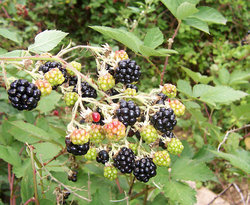| Blackberry | ||||||||||||||||
|---|---|---|---|---|---|---|---|---|---|---|---|---|---|---|---|---|
| Scientific classification | ||||||||||||||||
| ||||||||||||||||
| Species | ||||||||||||||||
| Rubus fruticosus - Common Blackberry |
The blackberry is a widespread and well known shrub; a bramble fruit (genus Rubus, family Rosaceae) growing to 3 m (10 ft) and producing a soft-bodied fruit popular for use in desserts, jams and sometimes wine. Several Rubus species are called blackberry and since the species easily hybridize, there are many cultivars with more than one species in their ancestry.
Marionberry is a cross between Chehalem and Olallieberry blackberries. It is said to "capture the best attributes of both berries and yields an aromatic bouquet and an intense blackberry flavor"[1] (http://www.oregon-berries.com/cx2/mk04f1a.htm). Olallieberry (sometimes spelled ollalieberry) in turn is a cross between loganberry and youngberry.
The blackberry has a scrambling habit of dense arching stems carrying short curved very sharp spines, the branches rooting from the node tip when they reach the ground. It is very pervasive, growing at fast daily rates in woods, scrub, hillsides and hedgerows, colonising large areas in a relatively short time. It will tolerate poor soil, and is an early coloniser of wasteland and building sites. It has palmate leaves of three to five leaflets with flowers of white or pink appearing from May to August, ripening to a black or dark purple fruit, the "blackberry".
The blackberry is also the fruit of the blackberry plant. In proper botanical language, it is not a berry at all, but instead an aggregate fruit of numerous drupelets.
In the photo at the upper right, the early flowers have formed more drupelets than the later ones. This can be a symptom of exhausted reserves in the plant's roots, marginal pollinator populations, or where a small change in conditions, such as a rainy day or a day too hot for bees to work after early morning, can reduce the number of bee visits/pollen grains delivered to the flower, thus reducing the quality of the fruit. The drupelets only develop around ovules which are fertilized by the male gamete from a pollen grain.
Blackberry blossoms are good nectar producers, and large acreages of wild blackberries will yield a medium to dark, fruity honey.
Superstition in the UK holds that blackberries should not be picked after 15th September as the devil has claimed them, having left a mark on the leaves. There is some value behind this legend, as after this date, wetter and cooler weather often allows the fruit to become infected by various moulds such as Botrytis, which give the fruit an unpleasant flavour and may be toxic. It is also not advisable to use or eat blackberries growing close to busy roads due to the accumulated toxins (e.g., lead) from the traffic.
The related but smaller European dewberry (R. caesius) can be distinguished by the white, waxy coating on the fruits, which also usually have fewer drupelets.
In some parts of the world, such as in New Zealand, blackberries are naturalized and considered a serious weed.
External links
- Blackberry Pollination Images (http://www.pollinator.com/blackberry.htm)
- Blackberry info (http://www.scintro.com/)
- Blackberry nutrition data (http://www.kallipolis.com/diet/food.php?id=9042)

